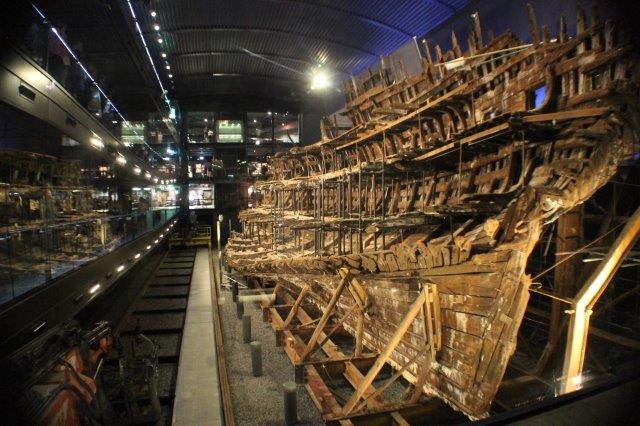FOR IMMEDIATE RELEASE | August 21, 2018
Bringing salvaged wooden ships and artifacts back to life with ‘smart’ nanotech
Note to journalists: Please report that this research will be presented at a meeting of the American Chemical Society.
A press conference on this topic will be held Tuesday, Aug. 21, at 9 a.m. Eastern time in the Boston Convention & Exhibition Center. Reporters may check-in at the press center, Room 102 A, or watch live on YouTube http://bit.ly/ACSLive_Boston2018. To ask questions online, sign in with a Google account.
BOSTON, Aug. 21, 2018 — Thousands of shipwrecks litter the seafloor all over the world, preserved in sediments and cold water. But when one of these ships is brought up from the depths, the wood quickly starts deteriorating. Today, scientists report a new way to use “smart” nanocomposites to conserve a 16th-century British warship, the Mary Rose, and its artifacts. The new approach could help preserve other salvaged ships by eliminating harmful acids without damaging the wooden structures themselves.
The researchers are presenting their results today at the 256th National Meeting & Exposition of the American Chemical Society (ACS). ACS, the world’s largest scientific society, is holding the meeting here through Thursday. It features more than 10,000 presentations on a wide range of science topics.
“This project began over a glass of wine with Eleanor Schofield, Ph.D., who is head of conservation at the Mary Rose Trust,” recalls Serena Corr, Ph.D., the project’s principal investigator. “She was working on techniques to preserve the wood hull and assorted artifacts and needed a way to direct the treatment into the wood. We had been working with functional magnetic nanomaterials for applications in imaging, and we thought we might be able to apply this technology to the Mary Rose.”
The Mary Rose sank in 1545 off the south coast of England and remained under the seabed until she was salvaged in 1982, along with over 19,000 artifacts and pieces of timber. About 40 percent of the original structure survived. The ship and its artifacts give unique insights into Tudor seafaring and what it was like to live during that period. A state-of-the-art museum in Portsmouth, England, displays the ship’s hull and artifacts. A video about the ship and its artifacts can be viewed here.
While buried in the seabed, sulfur-reducing marine bacteria migrated into the wood of the Mary Rose and produced hydrogen sulfide. This gas reacted with iron ions from corroded fixtures like cannons to form iron sulfides. Although stable in low-oxygen environments, sulfur rapidly oxidizes in regular air in the presence of iron to form destructive acids. Corr’s goal was to avoid acid production by removing the free iron ions.
Once raised from the seabed, the ship was sprayed with cold water, which stopped it from drying out and prevented further microbial activity. The conservation team then sprayed the hull with different types of polyethylene glycol (PEG), a common polymer with a wide range of applications, to replace the water in the cellular structure of the wood and strengthen its outer layer.
Corr and her postdoctoral fellow Esther Rani Aluri, Ph.D., and Ph.D. candidate Enrique Sanchez at the University of Glasgow are devising a new family of tiny magnetic nanoparticles to aid in this process, in collaboration with Schofield and Rachel O’Reilly, Ph.D., at the University of Warwick. In their initial step, the team, led by Schofield, used synchrotron techniques to probe the nature of the sulfur species before turning the PEG sprays off, and then periodically as the ship dried. This was the first real-time experiment to closely examine the evolution of oxidized sulfur and iron species. This accomplishment has informed efforts to design new targeted treatments for the removal of these harmful species from the Mary Rose wood.
The next step will be to use a nanocomposite based on core magnetic iron oxide nanoparticles that include agents on their surfaces that can remove the ions. The nanoparticles can be directly applied to the porous wood structure and guided to particular areas of the wood using external magnetic fields, a technique previously demonstrated for drug delivery. The nanocomposite will be encompassed in a heat-responsive polymer that protects the nanoparticles and provides a way to safely deliver them to and from the wood surface. A major advantage of this approach is that it allows for the complete removal of free iron and sulfate ions from the wood, and these nanocomposites can be tuned by tweaking their surfaces.
With this understanding, Corr notes, “Conservators will have, for the first time, a state-of-the-art quantitative and restorative method for the safe and rapid treatment of wooden artifacts. We plan to then transfer this technology to other materials recovered from the Mary Rose, such as textiles and leather.”
The researchers acknowledge funding from the Mary Rose Trust and the Leverhulme Trust.
The American Chemical Society, the world’s largest scientific society, is a not-for-profit organization chartered by the U.S. Congress. ACS is a global leader in providing access to chemistry-related information and research through its multiple databases, peer-reviewed journals and scientific conferences. ACS does not conduct research, but publishes and publicizes peer-reviewed scientific studies. Its main offices are in Washington, D.C., and Columbus, Ohio.
Media Contact
ACS Newsroom
newsroom@acs.org

Further use not permitted without written permission from the Mary Rose Trust.





